Marine Animals, Birds & Plants
Point Lobos is dramatically situated at the ocean edge of the enormous Pacific Ocean. It is no surprise that landscape artist Francis McComas called it the “greatest meeting of land and water in the world”. Its rocky coastline and offshore waters offer superb habitat for a huge diversity of plants and animals. The abundant marine life in this protected underwater reserve can be enjoyed in a multitude of ways, whether by gazing into the tide pools at Weston Beach at low tide, spotting California sea lions out on the rocks or sea otters wrapped in kelp off of the bluff at Sea Lion Point, or donning scuba gear to explore the undersea cliffs and canyons off Whalers and Bluefish Coves.
Marine mammals are among the biggest attractions to Point Lobos. Whether it is our iconic sea otter, our resident harbor seals and sea lions, or the whales and dolphins that pass by or stop in to dine in our bountiful ocean, visitors save their most
What is a marine mammal?
Marine mammals have evolved from land animals and share characteristics with their terrestrial relatives. A marine mammal, like its land-dwelling counterpart, is warm-blooded, is fur-bearing or has rudimentary hairs, gives birth to live young, and nurses its offspring. Marine mammals are beautifully adapted to life in or on the sea, enabling them to swim, dive, breathe, keep warm, and find food in the ocean. Some spend all their time in the ocean, while others may come on land but depend upon the ocean for some of their basic needs – most notably, food.
Marine mammals found at Point Lobos
Clearly, the poster child of marine mammals is the sea otter. Otters reside at Point Lobos year-round and breed in the Reserve as well. Other year-round marine mammals are the California sea lions and harbor seals. These two similar-looking animals are often confused by visitors, but as you will learn there are quite a few differences between them. Learning some of those differences can help you know which one you are seeing. Perhaps, however, you might be looking at a transient animal, an elephant seal or a Steller sea lion. Taken as a group all of these animals are called “pinnipeds.”
Otters and pinnipeds come out of the ocean to differing degrees (and in different kinds of places). The whales and dolphins (“cetaceans”), however, spend all their lives in the ocean, having relinquished their hind legs in the streamlining of their bodies to help them move through the water. When our visitors think of whales, they usually think of the California gray whale, which migrates past our shores every winter. But in recent years both humpback whales and blue whales have visited Point Lobos in the middle part of the year with increasing frequency. They come here to dine on the bountiful feast provided by our rich marine ecosystem. Other whales may be seen at times, but can be difficult to identify from shore.
Finally, dolphins and killer whales (orcas) are smaller cetaceans that never fail to delight visitors when pods of them are seen leaping through the water. The dorsal fins on their backs are larger, relative to body size, than the whales mentioned above. Some have said that orcas are more properly classified as dolphins, but in fact dolphins, porpoises, and orcas are all toothed whales.
Seasons of marine mammals will help you understand when different marine mammals can be seen at Point Lobos. reflective oohs and aahs for these magnificent animals.
Sea Otters

Sea otters (Enhydra lutris)
Sea otters (Enhydra lutris) are one of the main attractions at Point Lobos, and one of the most common questions from visitors is, “Where can I see otters?” They are the smallest marine mammals, considered by many to be the cutest by far. However they are related to weasels and wolverines, and known to have equally unpleasant temperaments – definitely not for cuddling!
Their main distinction from other marine mammals is their incredibly thick fur – the densest in the animal kingdom. Estimates of the number of hairs on this animal vary, but can be as high as one million per square inch! Comparing that with the 100,000 hairs on the fullest of human heads, it becomes almost unbelievable. You can feel the pelt for yourself at the Information Station, but you will only be touching the outer “guard” hairs. Under them is a layer of short hairs about 15-20 times as dense. That is where these animals work to trap air to form a layer of insulation against the very cold water (50-55° F) where they spend most of their time. Unlike the other marine mammals, they do not have the thick layer of blubber under the skin to insulate them.
Sea otters have something else to keep them warm – a very high metabolism fueled by the consumption of about 25% of their weight in food every day! Sea otters are rarely seen on land at Point Lobos for a variety of reasons. But they are well adapted to groom, eat, sleep, and socialize in the water (A group of sea otters is called a “raft”). When they sleep, they often wrap kelp over their bodies. The kelp is attached to the rocks below and assures that they will wake up in the same place. This trick also keeps them safe from predators and also makes them difficult for people to see when they are sleeping – be sure to bring your binoculars or borrow some at the Information Station. Better yet, join a free docent-led walk – you can find out when they are scheduled on the calendar.
Other interesting facts about sea otters:
- They can be 4.5 to 5.5 feet long and weigh 60 to 85 pounds, with adult males being larger.
- They are related to about 10 species of fresh water otters around the world, like the North American river otter, which is significantly smaller.
- They eat a wide variety of invertebrate animals, including mussels, clams, abalone and other snails, crabs, urchins, and octopus, to name a few. But the menus of individual otters tend to be limited to 5-6 items – the prey their mothers taught them to eat.
- They are among the relatively few tool-using animals in the world. They carry a rock in a fold under a foreleg. Underwater, it is used as a hammer to remove prey from the rocks, and on the surface it becomes an anvil on which to pound hard-shell animals to break them open. Sometimes you can find them by hearing the tap-tap-tap.
- In their mouths, they have sharp canine teeth and incisors in the front, and strong molars for crunching crab shells and the like. You can see for yourself at the Information Station.
- Technically, the otters at Point Lobos are southern sea otters, a separate subspecies from the northern sea otters off the coasts of Alaska and Asia as far south as Japan.
- Otters have few natural predators, although attacks by white sharks and killer whales have been documented. Humans hunted them for their valuable pelts from the mid-1700s until the early-1900s. The population was believed to be 15-20,000, ranging from Baja California to the Pacific Northwest before they were nearly brought to extinction. Fortunately, the fur hunters missed a few (generally thought to be less than 50) off Big Sur, and the residents of that then-isolated area kept their survival a secret until highway one was constructed between 1920 and 1940. By then, they were protected by law.
- Mating and birth of young occur throughout the year. After a gestation period of 6 to 8 months, sea otters usually give birth in the water. The mother teaches the pup everything it needs to know to survive, including finding and preparing food, and grooming the fur. Moms still need to forage when the pups are young, and pups are left bobbing on the surface while mom is below finding food. The pups’ thick, well-groomed fur keeps them afloat.
- Sea otters do not migrate, but they do move around a relatively small area in search of food. Therefore the number of otters at Point Lobos can vary between 30 and 80.
- Point Lobos docents do a monthly count of the otters along the Reserve’s coastline, and the US Geological Survey conducts a semiannual count along their entire range from Santa Barbara’s Channel Islands to about Half Moon Bay (south of San Francisco). The statewide count has been between 2800 and 3000 in recent years.
- Sea otters are listed as “threatened” on the Endangered Species Act, and strictly protected by law. The Sea Otter Research and Conservation (SORAC) [link] program of the Monterey Bay Aquarium watches the population very carefully and rescues sick, injured, and orphaned otters. It also recovers dead otters and studies the causes of death. The population has not recovered to earlier size due a number of reasons under active investigation. You can learn more on the SORAC website.
Seals, Sea Lions and Elephant Seals

Mother Harbor Seal with her pup
Harbor seals in the waters of Point Lobos State Natural Reserve. Photo credit: Diana Nichols.
Harbor Seals
Harbor seals (Phoca vitulina) are the quiet marine mammals resting on near shore rocks along the Point Lobos shoreline. They have spotted coats in a variety of shades from white or silver-gray to dark brown. The quiet behavior and camouflage coloration can make them easy to miss. Look carefully and you will find many seals here year round.
Harbor seals are torpedo-shaped and have short flippers. They can’t “walk” on land the way a sea lion can. Instead they flop along on their bellies. The awkward movement on land is in sharp contrast to their excellent adaptation underwater. They are graceful, curious and speedy swimmers, propelled by the webbed hind flipper. Unfortunately seals can’t out-swim their only predators – sharks and orcas.
They have no external ear flaps, just ear holes. This characteristic defines their group as “true seals.” Males tend to be slightly larger than females and can reach up to 250 pounds. The average length is 5 – 6 feet. They can live up to 20 years (males) and up to 30 years (females).
Harbor seals don’t migrate far from home. The seals you see today could be the same seals you see on your next visit to Point Lobos. Memorize the color and design of spots, unique to each seal, and you might even be able to find a familiar face!
They are day-sleepers, frequently misunderstood as lazy if you don’t realize they are nocturnal hunters. At nighttime they hunt within several miles of shore for fish, crabs, squid and octopus. Their large eyes and sensitive whiskers help locate prey. The average dive lasts less than 10 minutes and is relatively shallow, less than 300 feet.
Hauling out to rest and sleep is an important part of a seal’s routine. They spend about half their time on land and half in water. They can also sleep while in water. If you see just the nose of a seal sticking above the water, it’s in a resting position called “bottling.” While on land they are skittish and frighten easily. When watching seals it’s important to avoid loud noises and to maintain a distance that does not disturb them.
Respectful observation of seals is especially important during the pupping season. You can view this natural wonder in April and May at two primary locations within Point Lobos – Whalers Cove beach and China Cove beach. China Cove beach is closed during pupping season but the trail above offers a bird’s-eye view.
Female seals mature at 3-4 years. They can have one pup per year after a 9-month gestation. Gestation can be preceded by up to 3 months of delayed implantation. Expectant moms congregate at the same rookeries, usually beaches, where they were born. Pups weigh about 20 pounds and can swim within minutes of birth. Pups are nursed on mom’s rich milk and double their weight before weaning at approximately 4 weeks. After weaning, the previously devoted mom leaves the pup on its own.
Then it’s time to start the cycle again. Mating season is June through August. Males gather near rookeries to compete with other males and attract females by slapping the water with their flippers. Mating occurs underwater.
Steller Sea Lions
Steller sea lions (Eumetopias jubatus) were once abundant and commonly seen at Point Lobos as recently as the 1950’s. Nowadays, sighting a Steller is noteworthy. Fall and winter is the most likely time for this occasional visitor to appear mixed in among the California sea lions on the Sea Lion Rocks. The two species might be confused with one another because they share many physical characteristics. Both have long front flippers and rotating hind flippers enabling them to “walk” on land. Both have ear flaps and both are noisy, although an experienced listener can distinguish between the two “languages.” Searching from Sea Lion Point for a Steller requires binoculars in order to see the distinction between the two species.
Stellers are much larger and lighter in color than California sea lions, ranging from light tan to reddish brown. They have a blunt face and a boxy, bear-like head. Adult male Stellers have a bulky build and a very thick neck with longer fur that resembles a lion’s mane. Males can grow to 11 feet in length and weigh almost 2,500 pounds. The smaller females can grow to nine feet and weigh 1,000 pounds.
Adult males establish and defend breeding territories and form harems. There is a small rookery on Ano Nuevo Island, located offshore from Ano Nuevo State Park (about a 2 hour drive north of Point Lobos). This is the southernmost breeding area for the species. The largest concentration of Steller rookeries is in the Gulf of Alaska and Aleutian Islands.
Since the 1960’s, the population of Steller sea lions has declined by at least 50%. Due to this decline, Steller sea lions are now listed as a federally threatened species.
California Sea Lion
The noisy, barking California sea lion (Zalophus californianus) is the most conspicuous marine mammal at Point Lobos. They can be heard from most locations in the reserve. The name “Point Lobos” is derived from what the Spanish explorers called this area – “Punta de Los Lobos Marinos” which means the “point of the sea wolves.” Since sea lions bark while on land and offshore rocks, their barking was probably an aid to navigation for the first explorers, warning them of rocks in the fog.
Sea lions can be seen year-round although their numbers are less in summer. Sea Lion Point Trail offers a direct view to the Sea Lion Rocks offshore. A pair of binoculars will enhance the viewing experience. You will be amazed to see this large animal on top of the highest points. The long front and rotating hind flippers enable them to “walk” on land and to climb – whether it be on rocks, buoys, or boats in a marina.
Their solid color coats range from dark to golden brown. Adult males are significantly larger than females. Males can reach 650 pounds and 8 feet in length. Females can reach 220 pounds and about 6 feet in length. Look closely at their head and you will notice small ear flaps and long dog-like noses. Males 5 years and older develop a bony bump on top of their skull called a sagittal crest. Sea lions can live 20-30 years, with females tending to live longer than males.
Sea lions are very social animals. Large groups rest closely packed together on land, even sprawled over one another. They often float together on the water’s surface in rafts with one or both flippers raised out of the water. When first noticed, the flipper might be confused with the dorsal (back) fin of a whale or shark. The flipper is raised to help warm or cool the body – called thermoregulation. When not congregating together to rest, they can be seen swimming past the shoreline, sometimes jumping out of the water as they move along. This behavior is called “porpoising.” They are fast swimmers (reaching up to 25 mph), using the front flippers for propulsion and the hind flippers to steer.
Sea lions also hunt together. A typical dive for the sea lion is a few minutes long and down to 300 feet. Longer and deeper dives are possible. They are opportunistic feeders and not very picky, eating a wide variety of fish, squid, octopus and even small sharks. When the hunt for food leads them to species desired by humans, such as salmon, fishermen sometimes consider the sea lions as competition.
The sea lions at Point Lobos are mostly adult males and juveniles of both sexes. Adult males leave our central coast in early summer headed for the Channel Islands in southern California or for Mexico. These destinations are the breeding grounds. At the rookery the male tries to attract as many females as possible to his harem. Males remain there for about one month and then return to California and as far north as British Columbia.
Breeding age females remain near the rookeries all year and give birth in June or July. They stay with the newborn pup and nurse for at least 5 or 6 months, sometimes up to one year. Although still nursing, the females are ready to mate within 4 weeks of giving birth. Gestation is about 9 months and can be preceded by a 3-month delayed implantation period.
The population of California sea lions is considered stable. Their only natural predators are orcas and great white sharks. Fatalities can also be due to malnutrition, domoic acid poisoning (caused by a harmful algal bloom), cancer, entanglement in fishing debris and even gunshot wounds.
Elephant Seals
The northern elephant seal (Mirounga angustirostris) is an occasional visitor to Point Lobos. The adult male, with its large elongated nose, is enormous at over 2 tons and up to 16 feet; females are significantly smaller. Like harbor seals, elephant seals lack ear flaps and move on land by flopping along on the belly. If you look closely at an elephant seal you notice black whiskers instead of the harbor seal’s white whiskers. Sand flipping is another clue. An elephant seal flips sand on itself to help regulate body temperature.
Elephant seals are characterized by extraordinary behavior. They spend 80% of their life at sea foraging, only coming ashore to molt (shed hair and skin) and to mate for adults, or to rest for subadults. While at sea they lead a solitary life and cover long distances in search of food. Elephant seals dive deep in search of food. They are the deepest diving pinniped known with an average dive to 1800 feet and a maximum recorded depth of over 5000 feet.
The occasional sightings at Point Lobos might include a recently weaned pup who hasn’t learned to successfully forage and is suffering from malnutrition. The Marine Mammal Center rescues them, nurses them back to health and then releases them to the ocean. Subadults might also haul out on our beaches to rest. Less frequently an adult male might visit Point Lobos. Older animals rarely appear at Point Lobos.
For almost guaranteed elephant seal viewing, drive a couple hours to one of the nearby mainland rookeries. Ano Nuevo State Park is about 2 hours north of Point Lobos. Piedras Blancas rookery, the largest rookery, is a little over 2 hours drive to the south on the Big Sur coastline near San Simeon. Elephant seals haul out to molt at different times based on age and gender, so you can always see some elephant seals at the rookeries. Visit one of the rookeries during the winter birthing and breeding season for an amazing nature experience. In the not too distant past, elephant seals were highly endangered. They now number approximately 85,000.
Whales, Orcas, Dolphins and Porpoises

Whales
“Will I see a whale?” is a frequently asked question at Point Lobos. Nobody says, “Will I see a Cetacean?” which is the scientific name for a large group of sea mammals that have very streamlined body shapes, paddle-shaped front limbs, and tails that are flattened into flukes. Whales can be very large, like the blue whale, which can weigh up to 150 tons, or quite small like the harbor porpoise which is no larger than an average man. All whales are classified into two groups, the baleen whales (Mysticeti) and the toothed whales (Odantoceti), and both whale types can be seen (sometimes!) at Point Lobos.
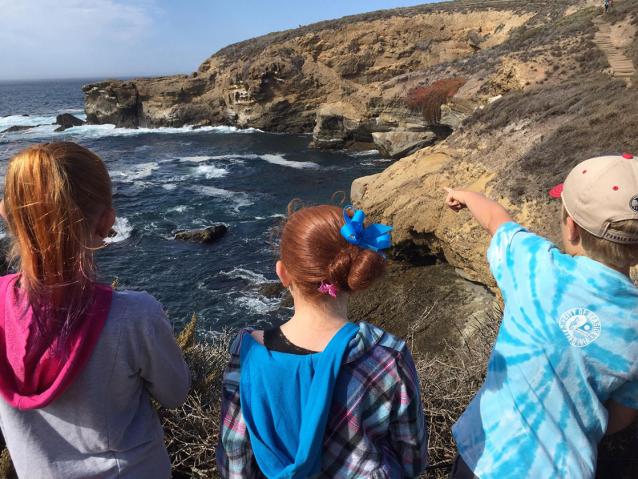
Toothed whales have just that – teeth! The population of toothed whales seen at Point Lobos includes orca or killer whales, as well as dolphins and porpoises that romp in the central Pacific Ocean. Toothed whales eat a variety of larger fish and other marine mammals. The orca is known for hunting the largest of all marine mammals, the baleen whales.
“How will I know when I see a whale?” Looking for spouts is the most common way to sight whales at Point Lobos. All whales must surface to breath air and the spout is caused by hot air from the whale’s lungs mixing with the cold ocean air. Gray whales and humpback whales have heart-shaped, or bushy, spouts and the humpback whale spout is larger than the gray whale’s. The heart shape is caused by the two blow holes in the head of these whales. The blue whale, largest of all whales, has a spectacular vertical single-column spout of up to 38 feet! Orcas, dolphins, and porpoises have a straight up spout since they have a single blow hole. The second blow hole in these whales’ skulls is used for sonar location! Flukes, those big tail flippers that can be seen when a whale dives, and dorsal fins, those large sails on the back of whales, are also features to look for when whale spotting.
Outside the Whaling Station Museum at Whalers Cove there is an excellent example of baleen, the stiff, broom-like jaw attachment that replaces teeth in three of the most often seen whales at Point Lobos: gray whales, humpback whales, and blue whales. Gray whale baleen is seen on the left. Baleen whales take huge gulps of sea water and food, and the baleen is used to separate them. Ocean water is squeezed through the baleen and sent back into the sea, and the small bits of food that are retained are then swallowed – like separating your spaghetti from the cooking water! Baleen whales eat a variety of small animals – whatever they can grab in their huge mouths!
Of the baleen whales that frequent Point Lobos, the blue whale and the humpback whale are listed as endangered. The total blue whale population is estimated as 10,000 – 25,000, but this population is dispersed throughout all the oceans of the world and in both near shore and deep ocean waters. The northeastern Pacific blue whale population is considered more stable that most others. The gray whale population is estimated at 25,000, but this population is only found near the eastern Pacific shore. Like blue whales, humpback whales are dispersed throughout the earth’s oceans and their population is estimated at 80,000.
In 1946 the International Whaling Commission was established and 1986 the IWC banned commercial whaling in order to increase the whale stock. However, some nations have chosen not to belong to the IWC and whaling continues in those countries. At the 2010 IWC meeting, representatives of the 88 member states discussed whether or not to lift the 24-year ban on commercial whaling. Japan, Norway and Iceland have urged the organization to lift the ban. A coalition of anti-whaling nations has offered a compromise plan that would allow these countries to continue whaling, but with smaller catches and under close supervision.
Humpback Whales
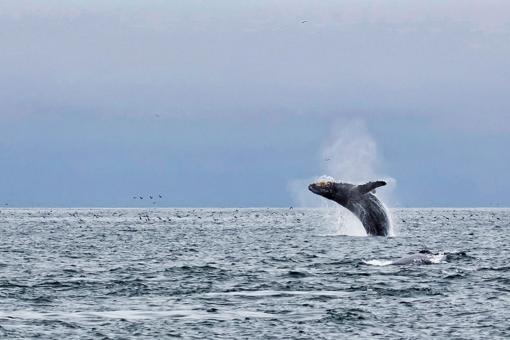
Humpback whales (Megaptera novaeangliae) and blue whales sightings are what many visitors think of as “seeing a whale.” Breaching, aerial acrobatics, fin slapping and those awesome spouts are the ultimate whale sighting experience. By contrast, the gray whales can reliably be sighted during their southern and northern migrations, but these animals are intent on getting to a destination and are spotted as they swim determinedly past Point Lobos. Humpback whales are following abundant food sources and with full bellies and no place to be, they breach, flap, and generally make a show of themselves. The favored foods of humpback whales are anchovies, squid, sardines, herring, krill – basically any small fish that swims in schools – and their baleen is used to take huge mouthfuls of fish and water, filter the water through the baleen back into the ocean, and swallow the retained fishes. A mature humpback whale will eat about 4000-5000 pounds of fish a day. Many of these calories are stored as blubber (fat) which insulates the animal as well as provides energy stores. An excellent example of humpback whale baleen is displayed outside the Whaling Station Museum at Whaler’s Cove.
Blue Whales
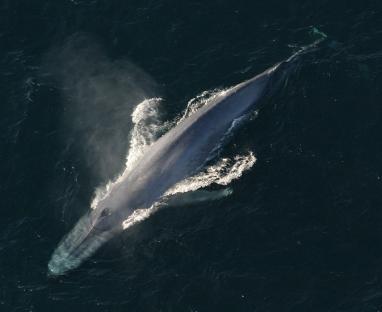
Blue whales (Balaenoptera musculus) are the largest of all whales and the largest animal on earth, reaching lengths of 100’ and weighing up to 150 tons. They are very streamlined, and as their name suggests, are a bluish-gray color. The blue whale feeds exclusively on krill. The blue whale can be distinguished by a very large, narrow spout that can reach 38 feet. An average spout is about 30 feet. The blue raises its head above the water to spout, resulting in a spectacular show of whale eyes, mouth, and water. This impressive spout is possible because the lung capacity of the blue whale is 1400 gallons! However, the blue whale is less acrobatic than the humpback whale so less likely to fully breech out of the water.
The northern Pacific blue whale is listed as endangered. World-wide, the blue whale population is estimated as 10,000 – 25,000, but this population is dispersed throughout all the oceans of the world, in both near shore and deep ocean waters. Several of these populations are considered endangered.
Gray Whales
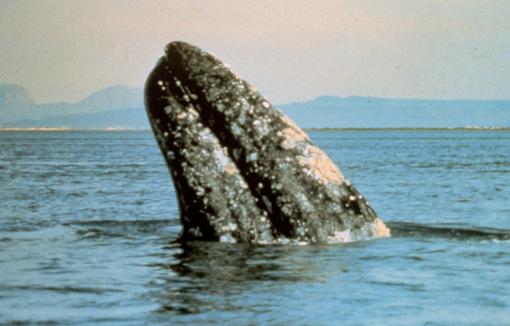
Gray whales (Eschrichtius robustus) are often thought of as “our” whales, but we do share them with Canada and Baja California. The native range is limited to the eastern shore of the Pacific Ocean. The gray whale is so unique that scientists classify it as the only member of the benthic whale family. Unlike other baleen whales that feed on schools of small fish and krill, the gray whale lies on its side in the ocean mud, stirs the mud with its flipper, and then takes in big mouthfuls of mud and small, benthic animals. The baleen is used to separate the muddy water, which is sent back into the ocean, and the small bits of food that are retained are then swallowed – like separating your spaghetti from the cooking water!
The time to most reliably see whales is during the gray whale migrations. Migrating whales often travel very close to shore, so viewing is excellent from Point Lobos – if you are there at the right time! During summer months, you won’t see gray whales as they are feeding in the mud of Alaskan waters. Many of the females are pregnant. When winter storms begin in October, the whales begin leaving their summer home and migrate south along the eastern Pacific coast. By late December through early February the migrating whales pass central California. These are whales with a mission: to reach the warm southern California waters before birthing and you won’t see them frolicking about. Since these whales begin their migration about the same time, they are often seen in groups, or pods.
If you miss the southern migration in winter, you have another chance to catch a gray whale sighting in late spring. Mating and birth take place in the warm waters of Baja California and then the gray whales are ready to begin the long trek home – another 6000 mile swim. Males and females without calves begin the northern migration first and pass central California from late March through May. The whales are eager to return to the rich, muddy feeding grounds of the north. Females with calves begin their migration as soon as the calf is strong enough to travel, like the one in the photo at left, so they are among the later whales passing Point Lobos. The female attempts to keep her calf as close to the shore as possible to protect it from attack by pods of orca whales. A female gray whale can lose one-third of her body weight as the long journey, birth and nursing consume stored fat, or blubber.
The gray whale can be recognized by its dark slate-gray skin which is mottled with white patches that result from barnacles attached to the skin, whale lice, and scars. A mature gray whale can weigh 30 – 40 tons and is about 40 – 50’ long; females are slightly larger than males. The grey whale gestation time is 13 months and females give birth every 2-3 years. The gray whale was hunted for its blubber (fat) which was used as lamp fuel before the discovery of kerosene and electricity. They were once called devil fish because of their fighting behavior when hunted. There are about 25,000 gray whales in the eastern Pacific and another small pod in the far north western Pacific, near Japan. A gray whale may live 55 – 70 years
Orcas

The spectacular orca, or killer whale, is one of the toothed whales for which population estimates are deficient. Some of the orca subspecies found along the northeast Pacific coast have been placed on the endangered list. These populations are estimated to be 2200 – 2700 animals. None of the dolphins or porpoises commonly seen at Point Lobos is considered endangered.
The largest dolphin species is the orca (Orcinus orca), or killer whale. A typical killer whale distinctively bears a black back, white chest and sides, and a white patch above and behind the eye. Calves are born with a yellowish or orange tint, which fades to white. It has a heavy and robust body with a large dorsal fin up to 6 feet tall in the males. Behind the fin, it has a dark grey “saddle patch” across the back. When seen from a distance, juveniles can be confused with other cetacean species, like the Risso’s dolphin. Male orcas grow to about 25 feet in length and weigh about 19,000 pounds.
The killer whale is also referred to as the orca whale or orca, and less commonly as the blackfish. Killer whales are found in all oceans. Killer whales as a species have a diverse diet, although individual populations often specialize in particular types of prey. Some feed exclusively on fish, while others hunt marine mammals and even large whales. The killer whale’s large size and strength make it among the fastest marine mammals, able to reach speeds in excess of 35 miles per hour. Killer whales have made appearances at Point Lobos during the gray whale migration from Baja to Alaska when the mother gray whale is traveling with her young calf from March through early May. The orcas will follow and attempt to prey on the calf while the mother gray whale will do everything in her power to protect it on this journey.
Killer whales are highly social; some populations are composed of family groups. Their sophisticated hunting techniques and vocal behaviors are often specific to a particular group and passed across generations.
Most dolphins live long lives. The bottlenose dolphin can live over 40 years, and the orca can live to be 70 or 80 years old!
Dolphins and Porpoises
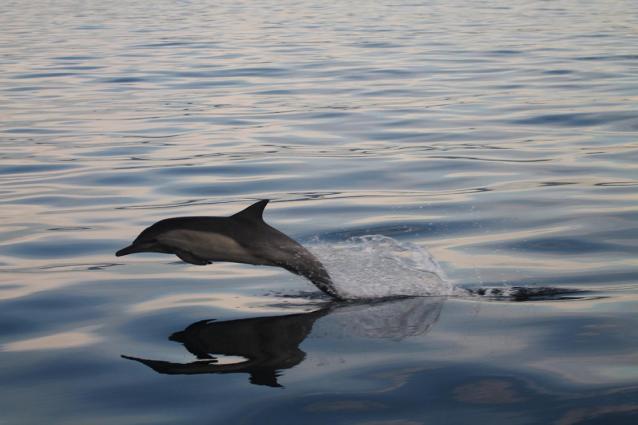
Seeing dolphins in the surf at Point Lobos is very exciting. These animals may travel alone or in groups. Dolphins are highly intelligent marine mammals and are very playful and fun to watch. They are part of a family of toothed whales that includes orcas, sperm whales and pilot whales. Dolphins are carnivores, mostly eating fish and squid.
Dolphin coloration varies, but they are generally gray in color and have darker backs than the rest of their bodies. Although it is difficult to identify the species unless you have binoculars and know the different markings, there are a few signs you can look for. Several species of dolphins visit the coast of California and the Monterey Bay Sanctuary. The most common are the Pacific white-sided dolphins (Lagenorhynchus obliquidens) and the Risso’s dolphins (Grampus griseus). Risso’s can be distinguished by their blunt snouts and the amount of scarring on their bodies caused by fighting with other Risso’s dolphis and with squid, their main food source. They are quite active and love to breach and tail slap. The Pacific White-sided Dolphin is found year-round but is most abundant during warmer water regimes in fall & winter. It ranges in the north Pacific from southeastern Alaska to Baja California. Sometimes these dolphins put on a truly impressive performance of leaps and aerial flips. They have been known to also swim in formation with other dolphins and sea lions, sometimes leaping from the water in spirited somersaults.
Other dolphins seen in the Monterey Bay include the long-beaked common dolphin (Lagenorhynchus obliquidens), a fast and energetic dolphin commonly seen breaching and somersaulting, the bottlenose dolphin (Tursiops truncatus) travelling just outside the breakers along sandy beaches, and the Dall’s porpoise (Phocoenoides dalli) that sometimes produces a “rooster tail” of water spray that is unique to this species.
The largest dolphin species is the orca (Orcinus orca), or killer whale. A typical killer whale distinctively bears a black back, white chest and sides, and a white patch above and behind the eye. Calves are born with a yellowish or orange tint, which fades to white. It has a heavy and robust body with a large dorsal fin up to 6 feet tall in the males. Behind the fin, it has a dark grey “saddle patch” across the back. When seen from a distance, juveniles can be confused with other cetacean species, like the Risso’s dolphin. Male orcas grow to about 25 feet in length and weigh about
Kelp Forest

Looking out at the ocean from the rocky headlands of Point Lobos, visitors usually notice the sometimes-thick collection of brownish seaweed. This is our kelp forest, most of which is giant kelp. It grows rapidly in up to 100 feet of depth, as it is connected to the bottom. It thrives best when attached to a rocky bottom. In summer the canopy is thick, but the kelp is not strong enough to stand up to strong winter wave surges, and the canopy becomes sparser.
The kelp forest provides protective habitat for a myriad of animals, and is the place to look for sea otters. But look carefully, as the otters blend in with the kelp when they sleep, and they wrap their bodies in the kelp to assure they won’t float away while sleeping.
The Great Kelp Forest
by Holly Hill, former Point Lobos park aide
It is an irresistible lure – the sea and its inhabitants. And, it would be difficult if not impossible for any naturalist to resist an inquiry into one of the most diverse, complex, and unique ecosystems on earth. This ecosystem is the great kelp forest.
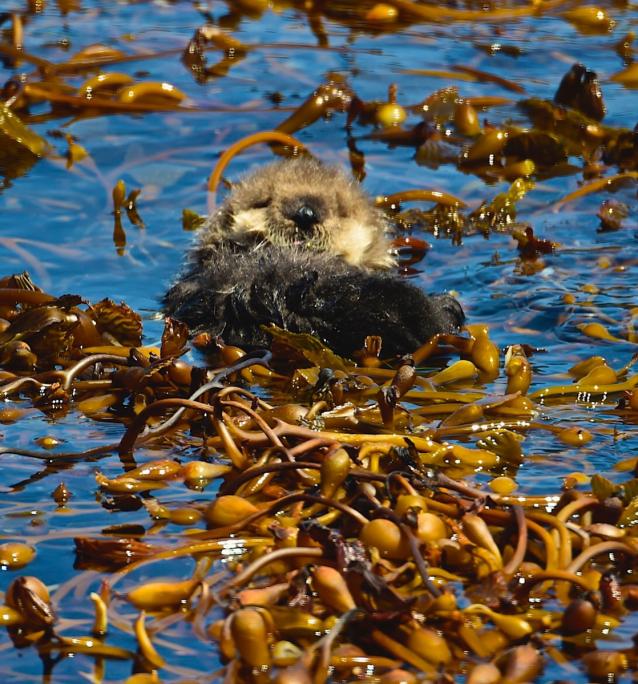 But what most of us refer to as “kelp” is actually one form of algae – brown algae, Phaephyta, which seemingly dominates cool (50° F 10° C) waters off the North American Pacific coast. Several species occur here, but it is the giant kelp, Macrocystis, and bull kelp, Nereocystis, that most of us encounter in nearshore waters as SCUBA divers, waders, boaters and kayakers.
But what most of us refer to as “kelp” is actually one form of algae – brown algae, Phaephyta, which seemingly dominates cool (50° F 10° C) waters off the North American Pacific coast. Several species occur here, but it is the giant kelp, Macrocystis, and bull kelp, Nereocystis, that most of us encounter in nearshore waters as SCUBA divers, waders, boaters and kayakers.
As for those who choose not to venture beyond the water’s edge, encounters with kelp are seasonally common when winter storms or heavy seas deposit mounds of entangled kelp “high and drying” along our beaches (much to the dismay of those living downwind of the decomposing tonage!).
These masses, known as “drift,” are something of a tribute and clue to the incredible growth rate (reportedly up to 18 to 24 inches a day) and success of these marine forest species.
Life for Macrocystis (and similarly for Nereocystis) begins as a spore released by the floatless reproductive blades – sporophylls – found near the holdfast (all Nereocystis blades are sporophylls) and these spores find substrate and develop into microscopic male and female plants. The male releases sperm and the female does release a single egg or several eggs. Nonetheless, unions of the two do occur, and from these the kelp plant with which we are familiar develops.
Growth begins at the holdfast where fronds, consisting of a stipe with numerous blades that are supported and pulled upward by the carbon monoxide-filled floats, lengthen as they seek the surface. This lengthening separates the new leaves which continue to grow and eventually form the kelp canopy. Old fronds that have died eventually become drift. The drift, in turn, is partially broken down to become a valuable food source for grazers such as abalone and sea urchins, while the larger masses of drift become buffered areas protecting juvenile fishes and other inhabitants from severe wave action and predation. And even beached drift continues to function in much the same way, providing food and protection for terrestrial organisms.
To say the kelp forest is complex and unique is clearly an understatement. Perhaps as we learn more, new words and terminologies will be coined to allow us to express the profound nature of the marine kelp forest.
PT. Lobos and the Ocean
The interface between the beautiful blue Pacific Ocean and the North American continent is what makes Point Lobos such a special place. Offshore, the ocean stretches for thousands of miles and plunges to depths of two miles, and even deeper in some places. It is an ever-changing environment populated by fish and other creatures, some which live in specific areas depths, and some which travel from one shore to the other and migrate vertically from near the surface to great depths.
Along the Point Lobos shoreline, the ocean plummets rapidly to several thousand feet in depth. Due to this topography and the prevailing weather conditions, we experience a phenomenon known as upwelling along the California central coast. This is the rising up of very cold, nutrient-rich waters from near the bottom of the ocean to the surface. From a biologist’s point of view, this phenomenon contributes to an astounding diversity of sea life along the coast. It also results in very cold water and the persistent fog that can often be seen and felt in the area.
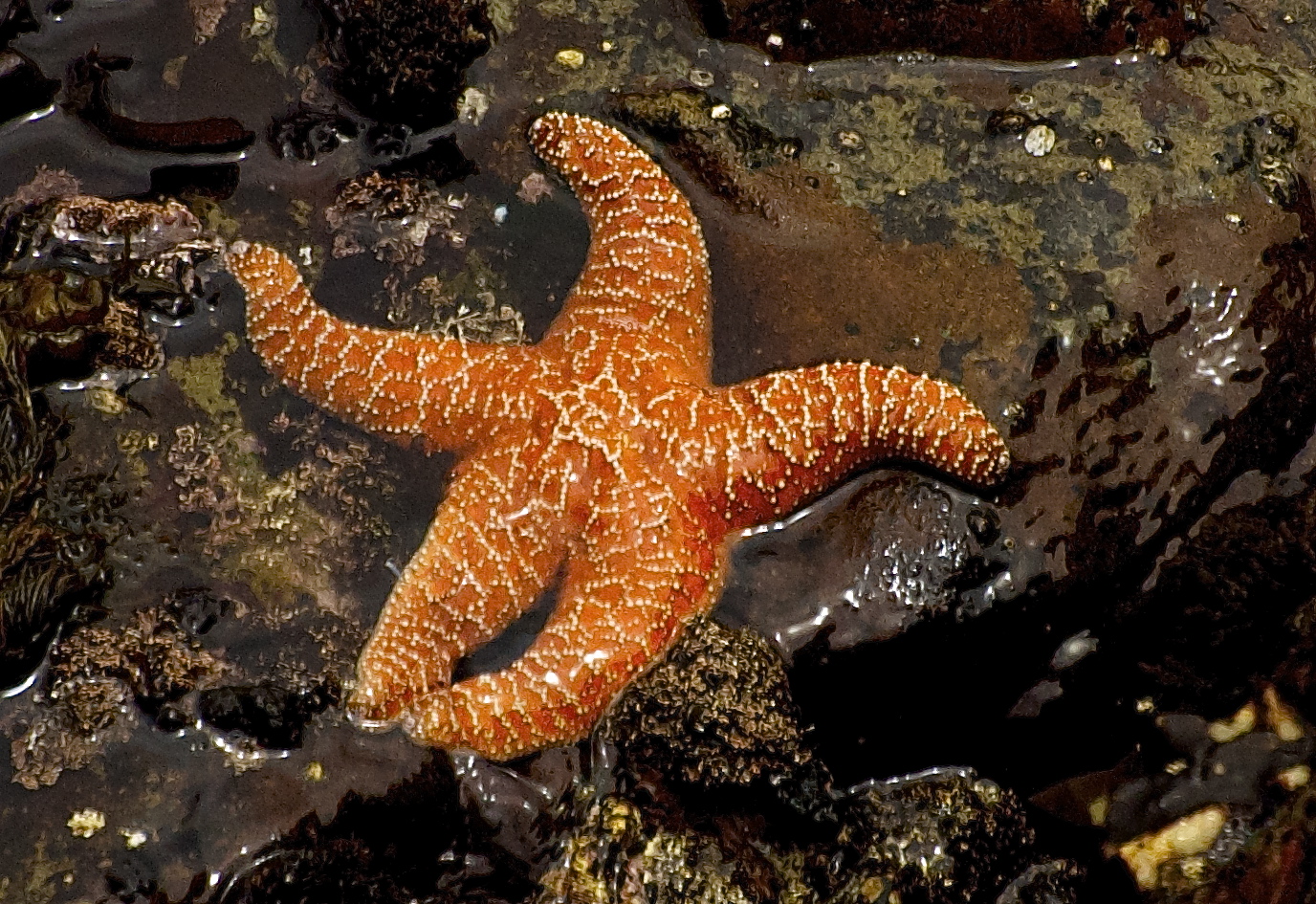
Tidepools
The constant motion of the tides and waves creates an ever-changing margin along the coast. As the water advances and recedes, it leaves pools – tide pools – in the rocky intertidal zone. At lower tides, these tide pools offer visitors an opportunity to view a variety of sea life up close.
The brochure “Weston Beach Tide Pools” is great to bring with you if you want to go tide pooling. It tells you more about intertidal zones and the sea life you might see at Point Lobos. It also has helpful information about how to keep you and the tide pool animals safe and tips to make the experience more meaningful for children.
Tide pools, areas along the margin between the ocean and a rocky shore, often provide an opportunity to see sea life up close. They are also great places to let kids see creatures in their natural environment. The best time to go tide pooling is near a low tide, the lower the better. And the best place to go at Point Lobos is Weston Beach, about halfway between the parking lots at Sea Lion Point and Bird Island along the South Shore road and trail.
There are two very important things to keep in mind if you decide to go tide pooling at Point Lobos.
- There are inherent hazards that you will face. The most serious is the threat of large waves knocking you down or sweeping you off the rocks. Never turn your back to the ocean. “Sneaker waves” can come in unexpectedly. The footing will probably be uneven and may be slippery. Be especially careful if you are unsteady on your feet or have children with you. You should wear boots or shoes that you don’t mind getting wet.
- The animals that you will see must not be harmed, nor may they be collected. Most of them cannot live outside their ocean environment. If you pick one up, you must put it back where you found it. Since Point Lobos is a nature reserve, even the shells and rocks must be left as you found them.
